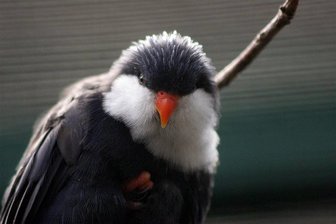Blue Lorikeet
The Violet Lorikeet is 18 cm long with a short rounded tail. Its plumage is mainly dark blue and it has a white area over its upper chest, throat and lower face. Erectile feathers on the top of its head show light blue streaks. Its beak is orange and its irises are yellow-brown. It has orange legs. Adult males and females have identical external appearance. The juvenile lacks the white plumage of the adult and has a dark grey-blue face and lower parts. The juvenile also has a black bill, dark brown irises, and its legs are orange brown.

Original source: Pierre de Chabannes (also at www.photozoo.org)Permission(Reusing this file)This image, which was originally posted to Flickr.com, was uploaded to Commons using Flickr upload bot on 14:05, 23 June 2009 (UTC) by Snowmanradio (talk). On that date it was licensed under the license below.This file is licensed under the Creative Commons Attribution 2.0 Generic license.You are free:to share – to copy, distribute and transmit the work
Author: Pierre de Chabannes (also at www.photozoo.org)Permission(Reusing this file)This image, which was originally posted to Flickr.com, was uploaded to Commons using Flickr upload bot on 14:05, 23 June 2009 (UTC) by Snowmanradio (talk). On that date it was licensed under the license below.This file is licensed under the Creative Commons Attribution 2.0 Generic license.You are free:to share – to copy, distribute and transmit the work
The Blue Lorikeet is classified as Vulnerable (VU), considered to be facing a high risk of extinction in the wild.
blue lorikeet (Vini peruviana) on Rangiroa atoll, Tuamotu Archipelago, French Polynesia" Notornis 50(1): 54-58 * Juniper & Parr (1998) Parrots: A Guide to Parrots of the World; ISBN 0-300-07453-0. Cited texts - * Forshaw, Joseph M. (2006). Parrots of the World; an Identification Guide. Illustrated by Frank Knight. Princeton University Press. ISBN 0691092516. More
Blue Lorikeet at San Diego Zoo, Calfornia © Steve Milpacher Blue Lorikeets at the San Diego Zoo, Calfornia © Steve Milpacher Page 1 of 1 pages Copyright © 2008 World Parrot Trust - All rights reserved. More
Adult blue lorikeet on leaf Adult blue lorikeet on leafPrint factsheet Facts - Also known as: Tahitian lorikeet/lory Spanish: Lori Monjita Kingdom Animalia Phylum Chordata Class Aves Order Psittaciformes Family Psittacidae Genus More
Videos and images Adult blue lorikeet on leaf This stout lorikeet is immediately identifiable by its striking pattern of white cheeks and bib against a mostly dark blue plumage, combined with an orange bill and legs. No less recognisable is this bird’s call, which consists of a very high-pitched ... More
Blue Lorikeet (Vini peruviana, also on Aitutaki in the Cook Islands) and the Ultramarine Lorikeet (Vini ultramarina), are also on the Red List and protected in the same way as the Rimatara Lorikeet. On Rimatara the lorikeet is still protected by a tapu placed on it by Queen Tamaeva about a hundred years ago. More
Blue Lorikeet (Vini peruviana) is a cute bird usually seen singly or in pairs, sometimes even in small groups (left). Extremely noisy, their high pitched, hissing screech, scheee-scheee scheee-scheee announce their presence even before they are seen. They are also excessively active, climbing the branches in search of flower nectar or flying around, even hovering as if suspended in the air. More
Adult male and female Blue Lorikeet have identical appearances of a predominantly dark blue body, with a small crest of lighter blue feathers on their heads. Adult birds have a white area covering the lower part of their face, throat and the upper part of the chest. This is missing from the juvenile birds, which also possess a black beak rather than the orange one of their parents. Grooming As with all Lorikeets, these birds require lots of fresh water. More
The first mention of the Blue Lorikeet on Aitutaki was in 1899 when it was referred to as the pet of the natives. Presumably it arrived as a cage-bird in the early 1800s on one of the many sailing ships from French Polynesia, where the species was still widespread. The Blue Lorikeet population has been surveyed several times in the last twelve years, although the lack of a standardised methodology has prevented realistic comparison of the results. More
Tags:animal animals birds Blue Lorikeet extinction parrot parrots Rainbow Lorikeet Rimatara Lorikeet Ultramarine Lorikeet Random Posts * Man gets Plunger up the Rump – Proves Fatal * How and Why we Kiss * Amazing Bicycle Powered by the Sun Invented * World Record Bubble Encircles 50 Kids * Artist Willard Wigan – Dreams DO Come True * Mara Triangle Animals on Brink More
Family : Psittacidae
Genus : Vini
Species : peruviana
Authority : (Müller, 1776)
